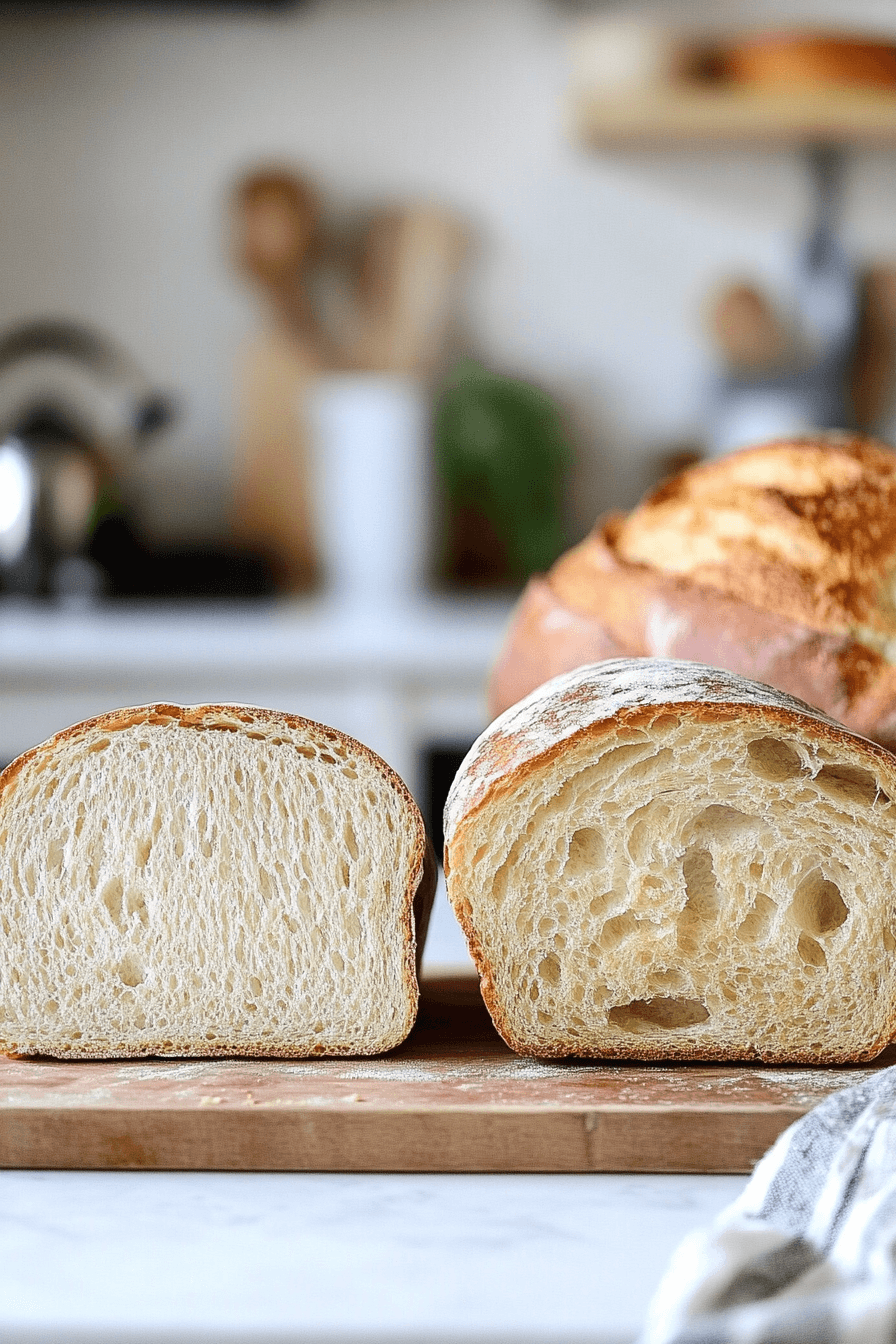When it comes to choosing the perfect bread for your meal, the options can be overwhelming. Two of the most common types are sandwich bread and regular bread. Understanding what is the difference is essential for selecting the right type for your culinary needs. In this article, we will break down the differences in texture, ingredients, flavor, and uses to help you make an informed decision.
Sandwich Bread vs Regular Bread: Overview
Manufacturers design sandwich bread for convenience, typically pre-slice it and make it soft, making it the go-to option for creating easy and quick sandwiches. On the other hand, regular bread encompasses a variety of styles, including rustic loaves, sourdough, and baguettes, which often have more complex textures and flavors.
If you’re curious about creating your own sandwich bread, you can learn to bake it at home with this recipe for a fresh result that’s perfect for sandwiches.
Learn more about the health benefits of whole grains and why they are a healthy option
Texture and Structure
The texture is one of the most obvious differences. Sandwich bread is characterized by its softness, making it easy to bite into without tearing or crumbling. This texture makes it ideal for sandwiches, as it complements various fillings without overwhelming them. Additionally, the uniform slicing ensures consistency in every bite.
In contrast, regular bread tends to have a crustier exterior and a denser crumb. Artisan loaves or sourdough varieties often provide a satisfying bite, making them perfect for heartier meals like soups or dipping. The variety of textures and shapes allows regular bread to be more versatile for culinary uses beyond just sandwiches.
Ingredients and Nutrition
One key difference lies in the ingredients used for their preparation. Bakers often enrich sandwich bread with ingredients like milk, butter, and sugar, which contribute to its softness and slightly sweet flavor. Bakers design this enriched dough to be light and airy, offering a pleasant texture that works well in sandwiches.
In contrast, bakers usually make regular bread from simpler ingredients, such as flour, water, yeast, and salt. These basic ingredients produce a denser and more rustic bread with a chewy texture and more complex flavors. The simpler ingredient list also makes regular bread a healthier option, as it often contains fewer additives and less sugar.
If you enjoy making sandwiches, pairing your bread with the right condiments can elevate the experience. Try a best burger sauce recipe for a flavorful addition that complements the soft texture of your sandwich bread.
Flavor Profiles
- Mild and Versatile Flavor of Sandwich Bread: it typically has a mild flavor, making it a great canvas for various sandwich ingredients. Its neutrality allows it to work well with both savory and sweet fillings, whether it’s meats, cheeses, or jams.
- Complex and Bold Flavors of Regular Bread: Regular bread, particularly varieties like sourdough or whole wheat, boasts more complex flavors. The fermentation process in sourdough, for example, produces a tangy taste, while whole grain breads may have nutty or earthy undertones. These richer flavors make regular bread a great choice for meals where the bread itself is a central part of the dish, such as with soups, stews, or toasted with toppings.
Culinary Uses
- Convenient Uses for Sandwich Bread: As the name suggests, it’s the best option for quick, convenient sandwiches. Its soft texture and even slices make it easy to use for a variety of fillings, and it holds up well to spreads like butter, mayonnaise, or condiments. Additionally, it’s perfect for making toasted sandwiches, or even quick breakfasts like French toast.
- Versatile Applications for Regular Bread: Regular bread can be used in a wider range of culinary contexts. Its crusty exterior and dense interior make it suitable for bruschetta, croutons, or even as an accompaniment to hearty soups. The texture of regular bread adds depth to any meal, and its flavor can complement both sweet and savory dishes.
If you’re looking to make your sandwiches even better, consider adding a homemade sauce. Discover what’s in a burger sauce that can take your sandwich to the next level.
Storage and Shelf Life
- How to Store Sandwich Bread: Keep it fresh by storing in an airtight container at room temperature for up to three days. For longer storage, freeze it for up to three months without losing softness or texture.
- How to Store Regular Bread: Store in an airtight container but enjoy fresh. Freeze leftovers, thaw properly to keep texture. Repurpose stale bread into breadcrumbs or croutons.

Frequently Asked Questions
1. Which Bread is Healthier:
Regular bread is generally considered healthier due to its simpler ingredient list. The lack of added sugars and fats found in sandwich bread makes regular bread a more wholesome choice, especially if you opt for whole grain or sourdough varieties.
2. Can I Use Sandwich Bread as a Substitute for Regular Bread?
Yes, you can use sandwich bread as a substitute in most cases, but keep in mind that its softer texture may not provide the same bite or depth of flavor as regular bread. For dishes that require a crusty or chewy texture, such as soups or dips, regular bread may be the better option.
3. How Can I Improve the Flavor of Sandwich Bread?
To enhance the flavor of sandwich bread, consider toasting it to create a crisp outer layer. You can also sprinkle seeds or herbs on the slices before toasting to add more complexity to the taste.
Conclusion
In conclusion, understanding the difference can help you make better decisions when preparing meals. While sandwich bread offers convenience, softness, and versatility for quick meals, regular bread provides richer flavors and textures that can enhance more complex dishes. Both types of bread have their unique strengths, so whether you prefer the simplicity of a sandwich or the depth of an artisan loaf, there’s a bread for every occasion.

